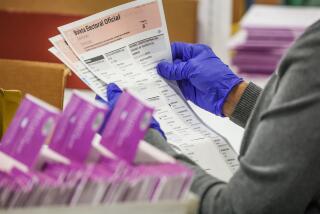Language Fluency Grows in Importance as Healing Tool
A2-year-old, severely abused boy recently was admitted to Northridge Hospital Medical Centerâs Trauma Center. The hospital staff needed to ask the childâs grandfather, who lived in Mexico and spoke only Spanish, to come to California to offer help and support.
Sonia Ramos, office manager at the Trauma Center who is fluent in Spanish, talked by telephone with the grandfather and worked with the American Embassy and Mexican Consulate to get an emergency visa for the family.
As the San Fernando Valley and the rest of Southern California become more culturally varied, this story is not uncommon. Incidents like this have created an enormous challenge for hospitals.
Northridge Hospital, for example, must be prepared to translate at least 15 languages for its culturally diverse patients and their families. The translation and interpretation needs can go beyond the basic, involving complex medical instructions or emotionally charged discussions about the risks of procedures and the probable outcomes of surgery or treatment.
And the task will only get more difficult. Since Jan. 1, a new section of the state Health and Safety Code requires that most hospitals develop a plan to provide language assistance to those who speak limited English or are hearing-impaired.
In 1990, 384,916 students in Los Angeles County were limited in their proficiency in English. The majority speak any of 35 different languages. Each child may be part of a family of adults and other children whose English proficiency is likely to be equally limited. Statewide, there has been a 52% increase between 1986 and 1990 in the number of students with limited English proficiency in California public schools, according to the Educational Demographic Unit of the state Department of Education, which has the most recent language-related data available.
To effectively serve this growing non-English-speaking population, hospital staffs also must be culturally sensitive, said Ken Chen, assistant medical group administrator at Kaiser Permanente Medical Center in Woodland Hills.
âItâs more than just language. We just had a situation in the intensive-care unit; the family members needed to wail at the bedside, even though the patient was in a coma. We offered the family a special room away from the patient, although they wanted to be in earshot of the patient. Weâre really confronted with new requests these days,â Chen said.
Most Valley hospitals reported that they have started to offer in-service classes to educate their staffs about cultural differences.
Hospitals with at least 5% non-English speaking patients must develop a plan to provide language assistance and translated documents such as consent and admitting forms. Facilities are required to identify a patientâs primary language and dialect on his medical record, maintain a list of interpreters and post signs to advise patients and their families that interpreters are available.
Such language support can be costly. George P. Rimalower, president of Interpreting Services International, a national interpreting and translating agency in Van Nuys, said he foresees problems arising from the wide-ranging needs hospitals and other service agencies will have for translation.
âHospitals canât pass these costs on to their patients,â Rimalower said.
Most hospitals fees are paid by insurers or the federal government, which base their rates on a patientâs diagnosis, not specific services. According to Richard D. Lyons, president and chief executive officer of Valley Hospital Medical Center in Van Nuys, âNinety percent of all care is paid for under predefined contracts unrelated to charges.â
In addition to using and training a multilingual staff--from orderlies and business office workers to licensed professionals--as translators and contracting with translation services such as ISI, other options are available to hospitals. AT&T;âs Language Line service provides hospitals with telephone translation of more than 140 languages, 24 hours a day. Health care workers can call an 800 number and a central operator directs the call to an appropriate interpreter. Northridge Hospital pays about $2 a minute for the service, plus a sign-up fee and monthly charge. Chen said Kaiser spends an average of $6,000 a month for each facility that uses the AT&T; service.
The demand for translation services is rising with the changing demographics. Rimalower said ISIâs gross income rose 62% from 1989 to 1990 and he is anticipating a 50% increase this year. He is most frequently asked to provide translation services locally in Spanish, Farsi, Russian, Hebrew, Mandarin, Cantonese, Tagalog, Vietnamese, Laotian and Korean.
Because of the cost--the fee for an interpreter from ISI ranges from $85 to $250 for half an hour, depending on the rarity of the language--Rimalower recommends that hospitals train their multilingual staffs to become medical interpreters. Even though staff members may speak other languages fluently, additional training is essential because many people are unfamiliar with medical terminology, symptoms, injuries, protocol, confidentiality and ethics, he said.
âNot everyone instinctively knows that you cannot editorialize on what is said when youâre translating,â he explained.
Without special translation training, a bilingual person often leaves the heart-wrenching material out.
âYou have to be trained to be able to tell a parent, âYour child may die,â â he said.
Sometimes the need for translation services arises from visitors to the hospital rather than patients. Chen described a recent tour of elementary school students that stopped in an empty operating room. âA child froze in panic, then started screaming and screaming. We didnât even know what language he was speaking, but someone figured out it was Armenian and we found someone on staff who could talk to him,â Chen said. The child had lived in a war zone and had been told that the operating room was a place people go to die, Chen explained.
In addition to developing effective translation systems to cope with the medical and ethical issues surrounding language barriers, hospitals also realize that they need to market themselves to their neighborhood communities.
âThe flavor of L. A. has been changing and I think itâs important we present ourselves as a place where different languages are welcome,â Chen said. âItâs also a business strategy. The environment is changing and we need to adjust accordingly,â he added.
Valley Hospital Medical Center recently instituted a program to make itself Spanish-friendly. The hospital now has bilingual signs, an after-hours paid language education program for employees and a bilingual differential for certain positions.
âThe institution has to reflect the community that itâs in,â Lyons said. âWe have a strong commitment at all levels that we need to be language-sensitive and culturally sensitive as well. You canât serve health needs if you canât communicate.â
More to Read
Sign up for Essential California
The most important California stories and recommendations in your inbox every morning.
You may occasionally receive promotional content from the Los Angeles Times.










